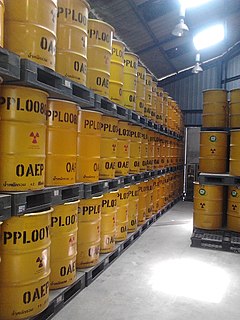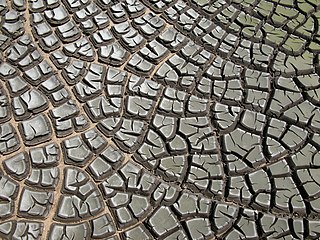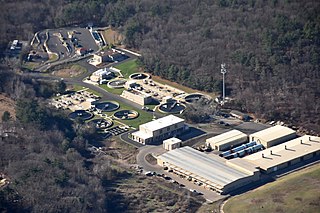See also
- Waste management – re-use, recycling and disposal of solid waste from manufacturing, commerce and domestic sources.
Conventional wastewater treatment refers to various methods of treating different categories of wastewater, and may include any of the following:

Radioactive waste is a type of hazardous waste that contains radioactive material. Radioactive waste is a result of many activities, including nuclear medicine, nuclear research, nuclear power generation, rare-earth mining, and nuclear weapons reprocessing. The storage and disposal of radioactive waste is regulated by government agencies in order to protect human health and the environment.

Sewage sludge is the residual, semi-solid material that is produced as a by-product during sewage treatment of industrial or municipal wastewater. The term "septage" also refers to sludge from simple wastewater treatment but is connected to simple on-site sanitation systems, such as septic tanks.

Industrial waste is the waste produced by industrial activity which includes any material that is rendered useless during a manufacturing process such as that of factories, mills, and mining operations. Types of industrial waste include dirt and gravel, masonry and concrete, scrap metal, oil, solvents, chemicals, scrap lumber, even vegetable matter from restaurants. Industrial waste may be solid, semi-solid or liquid in form. It may be hazardous waste or non-hazardous waste. Industrial waste may pollute the nearby soil or adjacent water bodies, and can contaminate groundwater, lakes, streams, rivers or coastal waters. Industrial waste is often mixed into municipal waste, making accurate assessments difficult. An estimate for the US goes as high as 7.6 billion tons of industrial waste produced annually, as of 2017. Most countries have enacted legislation to deal with the problem of industrial waste, but strictness and compliance regimes vary. Enforcement is always an issue.
Wastewater is any water used to transport waste, and is most commonly a synonym for:
Waste treatment refers to the activities required to ensure that waste has the least practicable impact on the environment. In many countries various forms of waste treatment are required by law.

Wastewater treatment is a process used to remove contaminants from wastewater and convert it into an effluent that can be returned to the water cycle. Once returned to the water cycle, the effluent creates an acceptable impact on the environment or is reused for various purposes. The treatment process takes place in a wastewater treatment plant. There are several kinds of wastewater which are treated at the appropriate type of wastewater treatment plant. For domestic wastewater, the treatment plant is called a sewage treatment plant. For industrial wastewater, treatment either takes place in a separate industrial wastewater treatment plant, or in a sewage treatment plant. Further types of wastewater treatment plants include agricultural wastewater treatment plants and leachate treatment plants.

Low-level waste (LLW) is nuclear waste that does not fit into the categorical definitions for intermediate-level waste (ILW), high-level waste (HLW), spent nuclear fuel (SNF), transuranic waste (TRU), or certain byproduct materials known as 11e(2) wastes, such as uranium mill tailings. In essence, it is a definition by exclusion, and LLW is that category of radioactive wastes that do not fit into the other categories. If LLW is mixed with hazardous wastes, then it has a special status as mixed low-level waste (MLLW) and must satisfy treatment, storage, and disposal regulations both as LLW and as hazardous waste. While the bulk of LLW is not highly radioactive, the definition of LLW does not include references to its activity, and some LLW may be quite radioactive, as in the case of radioactive sources used in industry and medicine.

Biosolids are solid organic matter recovered from a sewage treatment process and used as fertilizer. In the past, it was common for farmers to use animal manure to improve their soil fertility. In the 1920s, the farming community began also to use sewage sludge from local wastewater treatment plants. Scientific research over many years has confirmed that these biosolids contain similar nutrients to those in animal manures. Biosolids that are used as fertilizer in farming are usually treated to help to prevent disease-causing pathogens from spreading to the public.

Agricultural wastewater treatment is a farm management agenda for controlling pollution from confined animal operations and from surface runoff that may be contaminated by chemicals in fertilizer, pesticides, animal slurry, crop residues or irrigation water. Agricultural wastewater treatment is required for continuous confined animal operations like milk and egg production may be performed in plants using mechanized treatment units similar to those used for industrial wastewater; but where land is available for ponds, settling basins and facultative lagoons may have lower operational costs for seasonal use conditions from breeding or harvest cycles.

Industrial wastewater treatment describes the processes used for treating wastewater that is produced by industries as an undesirable by-product. After treatment, the treated industrial wastewater may be reused or released to a sanitary sewer or to a surface water in the environment. Most industrial processes, such as petroleum refineries, chemical and petrochemical plants have onsite facilities to treat their wastewaters so that the pollutant concentrations in the treated wastewater comply with the regulations regarding disposal of wastewaters into sewers or into rivers, lakes or oceans. Industrial wastewater treatment plants are required where municipal sewage treatment plants are unavailable, do not have sufficient capacity or cannot adequately treat specific industrial wastewaters.
Milorganite is a brand of biosolids fertilizer produced by treating sewage sludge by the Milwaukee Metropolitan Sewerage District. The term is a portmanteau of the term Milwaukee Organic Nitrogen. The sewer system of the District collects municipal wastewater from the Milwaukee metropolitan area. After settling, wastewater is treated with microbes to break down organic matter at the Jones Island sewage treatment plant in Milwaukee, Wisconsin. The byproduct sewage sludge is produced. This is heat-dried with hot air in the range of 900–1,200 °F (482–649 °C), which heats the sewage sludge to at least 176 °F (80 °C) to kill pathogens. The material is then pelletized and marketed throughout the United States under the name Milorganite. The result is recycling of the nitrogen and phosphorus from the waste-stream as fertilizer. The treated wastewater is discharged to Lake Michigan.
There are many uses of water in industry and, in most cases, the used water also needs treatment to render it fit for re-use or disposal. Raw water entering an industrial plant often needs treatment to meet tight quality specifications to be of use in specific industrial processes. Industrial water treatment encompasses all these aspects which include industrial wastewater treatment, boiler water treatment and cooling water treatment.
There are a number of different waste treatment technologies for the disposal, recycling, storage, or energy recovery from different waste types. Each type has its own associated methods of waste Management

Sewage treatment is a type of wastewater treatment which aims to remove contaminants from sewage. Sewage contains wastewater from households and businesses and possibly pre-treated industrial wastewater. Physical, chemical, and biological processes are used to remove contaminants and produce treated wastewater that is safe enough for release into the environment. A by-product of sewage treatment is a semi-solid waste or slurry, called sewage sludge. The sludge has to undergo further treatment before being suitable for disposal or application to land. The term "sewage treatment plant" is often used interchangeably with the term "wastewater treatment plant".

Under United States environmental policy, hazardous waste is a waste that has the potential to:

Sewage is a type of wastewater that is produced by a community of people. It is characterized by volume or rate of flow, physical condition, chemical and toxic constituents, and its bacteriologic status. It consists mostly of greywater, blackwater ; soaps and detergents; and toilet paper. Proper collection and safe, nuisance-free disposal of the liquid wastes of a community are legally recognized as a necessity in an urbanized, industrialized society.

Water pollution in the United States is a growing problem that became critical in the 19th century with the development of mechanized agriculture, mining, and industry, although laws and regulations introduced in the late 20th century have improved water quality in many water bodies. Extensive industrialization and rapid urban growth exacerbated water pollution as a lack of regulation allowed for discharges of sewage, toxic chemicals, nutrients and other pollutants into surface water.
Solid waste policy in the United States is aimed at developing and implementing proper mechanisms to effectively manage solid waste. For solid waste policy to be effective, inputs should come from stakeholders, including citizens, businesses, community based-organizations, non governmental organizations, government agencies, universities, and other research organizations. These inputs form the basis of policy frameworks that influence solid waste management decisions. In the United States, the Environmental Protection Agency (EPA) regulates household, industrial, manufacturing, and commercial solid and hazardous wastes under the 1976 Resource Conservation and Recovery Act (RCRA). Effective solid waste management is a cooperative effort involving federal, state, regional, and local entities. Thus, the RCRA's Solid Waste program section D encourages the environmental departments of each state to develop comprehensive plans to manage nonhazardous industrial and municipal solid waste.
Resource recovery is using wastes as an input material to create valuable products as new outputs. The aim is to reduce the amount of waste generated, thereby reducing the need for landfill space, and optimising the values created from waste. Resource recovery delays the need to use raw materials in the manufacturing process. Materials found in municipal solid waste, construction and demolition waste, commercial waste and industrial wastes can be used to recover resources for the manufacturing of new materials and products. Plastic, paper, aluminium, glass and metal are examples of where value can be found in waste.